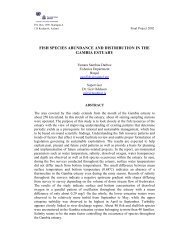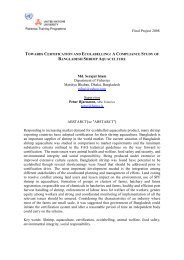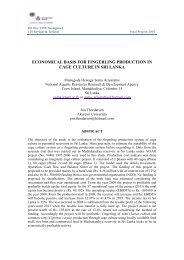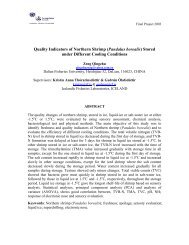Evaluation and Utilisation of Fish Protein Isolate Products
Evaluation and Utilisation of Fish Protein Isolate Products
Evaluation and Utilisation of Fish Protein Isolate Products
- No tags were found...
You also want an ePaper? Increase the reach of your titles
YUMPU automatically turns print PDFs into web optimized ePapers that Google loves.
Fresh CPS with 20% saltViscosity (BU)10.55040302010Temperature ˚C01 3 5 7 9 11 13 15 17 19 21 23 25 27 29 31 33Time (minute)Day 2 Day 5 Temperature range0Figure 9: Temperature-dependent flow behaviour <strong>of</strong> CPS containing 15% salt during 5 days <strong>of</strong> storage at +2 ˚C3.6.2 Frozen CPSSamples containing salt <strong>and</strong> samples containing cryoprotectant had different flowbehaviours during 14 weeks <strong>of</strong> storage at -24˚C. There were few differences between flowbehaviour <strong>of</strong> each sample containing the same amount <strong>of</strong> salt or cryoprotectants within 14weeks <strong>of</strong> storage.Samples containing 1.2% salt with or without cryoprotectants had rheopectic behaviour(Figures 10 <strong>and</strong> 11); but samples containing 3% salt had rheopectic flow. Surprisingly, thissample with cryoprotectants had thixotropic flow behaviour (Figures 12 <strong>and</strong> 13).Frozen CPS with 1.2% saltViscosity (BU)7060504030201001 3 5 7 9 11 13 15 17 19 21 23 25 27 29 31 33Time (minute)Week 2 Week 8 Week 14 Temperature range50403020100Temperature ˚CFigure 10: Flow behaviour <strong>of</strong> CPS containing 1.2% salt during 14 weeks <strong>of</strong> storage at -24 ˚C30
















